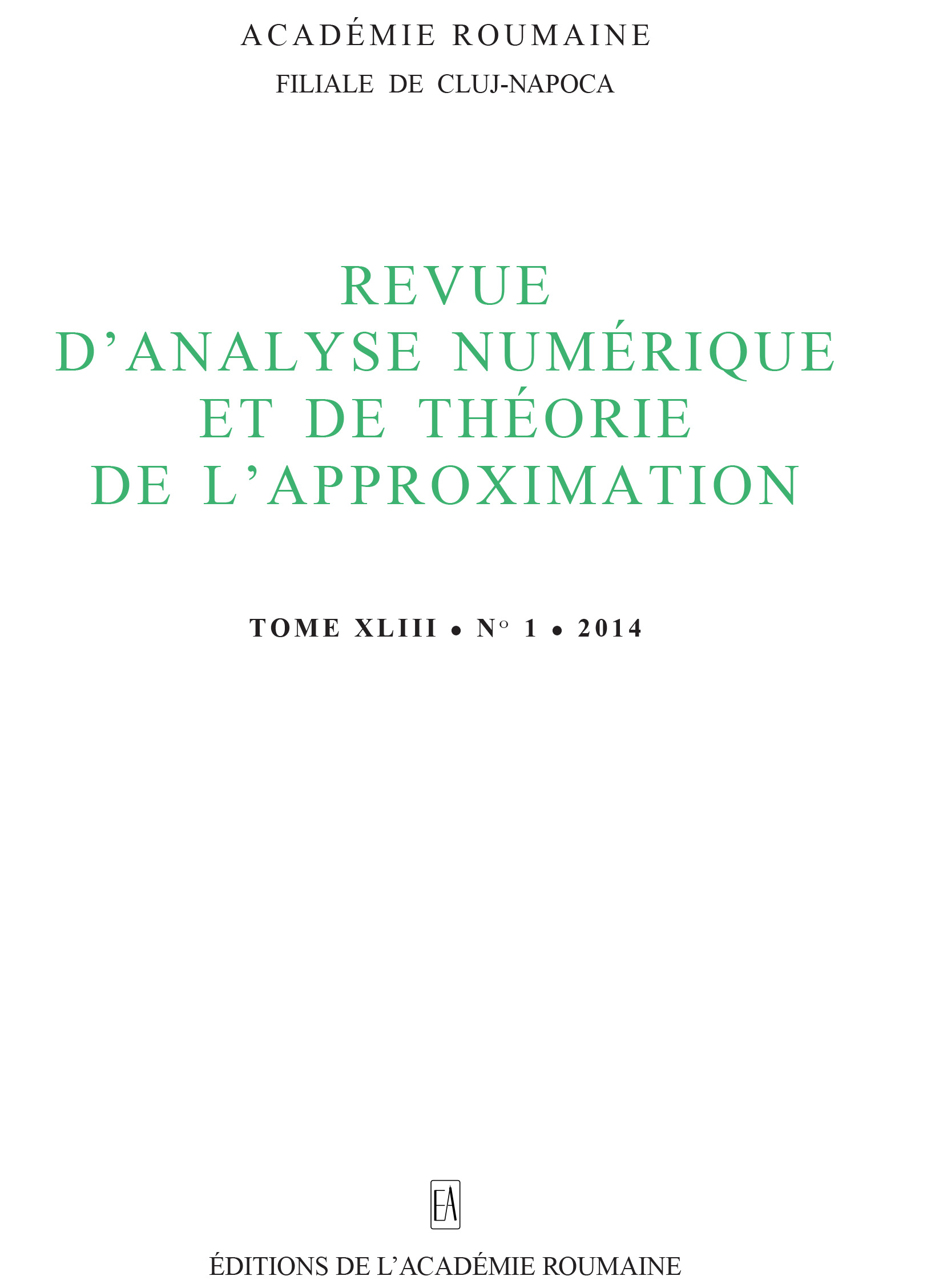On approximating the solutions of nonlinear equations by a method of Aitken-Steffensen type
DOI:
https://doi.org/10.33993/jnaat431-995Keywords:
convergence of the method of the Aitken-Steffensen typeAbstract
This paper completes the results that are presented in [14]. Using as a starting point the abstract method of the chord, in the mentioned paper we have presented an iterative method of approximation for the solutions of an equation. This method uses auxiliary sequences, and aims to improve the convergence order. The used method generalizes the method of Aitken-Steffensen. In the paper [14] we have given the statement of the main theorem and the statement and the proof of an auxiliary proposition concerning the convergence of some recurrence sequences of real numbers. In the present paper we give the proof of the main result and at the same time we discuss an interesting special case.Downloads
References
I. K. Argyros, Polynomial Operator Equation in Abstract Spaces and Applications, CRC Press Boca Raton Boston London New York Washington D.C., 1998.
M. Balázs, On the chord method for solving nonlinear opertorial equations, Studii şi Cercetări Matematice, 20 (1968) no. 2, pp. 129-136 (in Romanian).
M. Balázs and G. Goldner, Divided differences in Banach spaces and applications, Studii şi Cercetări Matematice, 21 (1969) no. 7, pp. 985-986 (in Romanian).
M. Balázs, On applying the chord method to the solving of nonlinear integral equations, Studii şi Cercetări Matematice, 23 (1971) no. 6, pp. 841-844 (in Romanian).
M. Balázs and G. Goldner, On existence of divided differences in linear spaces, Rev. Anal. Numér. Théor. Approx., 2 (1973), pp. 5-9, http://ictp.acad.ro/jnaat/journal/article/view/2007-vol36-no1-art5
J. G. P. Barnes, An algorithm for solving nonlinear equations based on the secant method, Comput. J., 8 (1965), pp. 55-72. DOI: https://doi.org/10.1093/comjnl/8.1.66
A. Diaconu, Interpolation dans les espaces abstraits. Méthodes itératives pour la résolution des équations opérationnelles obtenues par l'interpolation inverse (I), "Babeş-Bolyai" University, Faculty of Mathematics, Research Seminaries, Seminar of Functional Analysis and Numerical Methods, Preprint no. 4 (1981), pp. 1-52, (in French).
A. Diaconu, Interpolation dans les espaces abstraits. Méthodes itératives pour la résolution des équations opérationnelles obtenues par l'interpolation inverse (II), "Babeş-Bolyai" University, Faculty of Mathematics, Research Seminaries, Seminar of Functional Analysis and Numerical Methods, Preprint no. 1 (1984), pp. 41-97, (in French).
A. Diaconu, Interpolation dans les espaces abstraits. Méthodes itératives pour la résolution des équations opérationnelles obtenues par l'interpolation inverse (III), "Babeş-Bolyai" University, Faculty of Mathematics, Research Seminaries, Seminar of Functional Analysis and Numerical Methods, Preprint no. 1 (1985), pp. 21-71, (in French).
A. Diaconu, Remarks on interpolation in certain linear spaces (I), Studii în Metode de Analiză Numerică şi Optimizare, Chişinău: USM-UCCM, 2-1 (2000) no. 3, pp. 3-14.
A. Diaconu, Remarks on interpolation in certain linear spaces (II), Studii în Metode de Analiză Numerică şi Optimizare, Chişinău: USM-UCCM, 2-2 (2000) no. 4, pp. 143-161.
A. Diaconu, On the interpolation in linear spaces, Mathematica Pannonica, 14 (2003) no. 2, pp. 205-216.
A. Diaconu, On the chord method in linear normed spaces, Topics in mathematics, computer science and philosophy, pp. 73-94, Presa Univ. Clujeana, Cluj-Napoca, Romania, 2008.
A. Diaconu, On approximating the solutions of equations by the chord method and a method of Aitken-Steffensen type, Rev. Anal. Numér. Théor. Approx., 42 (2013) no. 2, pp. 132-150, http://ictp.acad.ro/jnaat/journal/article/view/2013-vol42-no2-art6
G. Goldner and M. Balázs, On the chord method and on a modification of it for solving nonlinear operatorial equations, Studii şi Cercetări Matematice, 7 (1968) no. 20, pp. 981-990 (in Romanian).
B. Janko and M. Balázs, On the chord method for solving nonlinear operatorial equations in normed spaces, Studii şi Cercetări Matematice, 19 (1967) no. 10, pp. 1433-1436 (in Romanian).
L. V. Kantorovich, Functional analysis and applied mathematics, U.M.N. III, 5 (1948) no. 28, pp. 29-185 (in Russian).
L. V. Kantorovich, Functional Analysis, Editura Ştiinţifică şi Enciclopedică, Bucureşti, 1986 (in Romanian).
V. L. Makarov and V. V. Hlobistov, Osnovî teorii polinomialnogo operatornogo interpolirovania, Institut Mathematiki H.A.H. Ukrain, Kiev, (1998) (in Russian).
I. Păvăloiu, Considerations on the iterative methods obtained by inverse interpolation, Studii şi Cercetări Matematice, 23 (1971) no. 10, pp. 1545-1549 (in Romanian).
I. Păvăloiu, Interpolation dans des espaces linéaires normés et application, Mathematica (Cluj), 12, 1 (1970) no. 35, pp. 149-158 (in French).
I. Păvăloiu, Introduction to the Theory of Approximating the Solutions of Equations, Editura Dacia, Cluj-Napoca, 1976, (in Romanian).
P. M. Prenter, Lagrange and Hermite interpolation in Banach spaces, J. Approx. Theory, 4 (1971), pp. 419-432. DOI: https://doi.org/10.1016/0021-9045(71)90007-4
A. S. Sergeev, O metode hord, Sibirski mat. Journal, 11 (1961) no. 2, pp. 282--289 (in Russian).
S. Ul'm, Ob interpolationih metodah resenia uravnenii v postransve Banaha, Izv. Acad. Nauk Estonskoi S.S.R., 1 (1963), pp. 24-30 (in Russian).
S. Ul'm, Ob odnom classe iterationnih metodav v postransve Ghilberta, Izv. Acad. Nauk Estonskoi S.S.R. 2 (1963), pp. 132-140 (in Russian).
S. Ul'm, Ob obobscennyh razdelennih raznostiah I., Izv. Acad. Nauk Estonskoi S.S.R. 16 (1967) no. 1, pp. 13-36 (in Russian).
S. Ul'm, Ob obobscennyh razdelennih raznostiah II., Izv. Acad. Nauk Estonskoi S.S.R., 16 (1967) no. 2, pp. 146-155 (in Russian).
Published
Issue
Section
License
Copyright (c) 2015 Journal of Numerical Analysis and Approximation Theory

This work is licensed under a Creative Commons Attribution 4.0 International License.
Open Access. This article is distributed under the terms of the Creative Commons Attribution 4.0 International License, which permits unrestricted use, distribution, and reproduction in any medium, provided you give appropriate credit to the original author(s) and the source, provide a link to the Creative Commons license, and indicate if changes were made.










